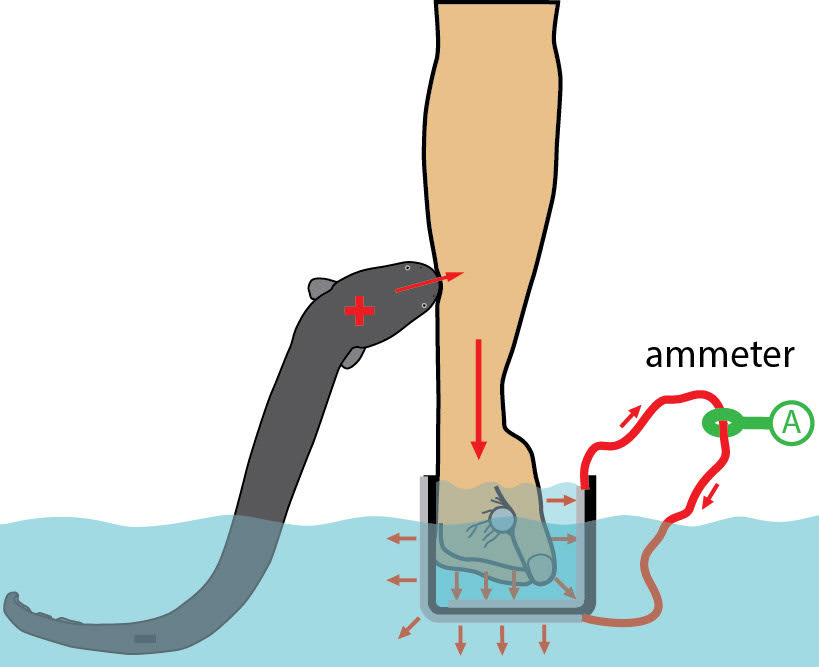It’s no secret that the electric eel (Electrophorus electricus) is a species not to be messed with. Capable of generating an electric discharge of more than 800 volts, the enigmatic tropical fish can easily stun prey and would-be predators alike. Land-lubbing assailants aren’t safe either; the eels can breach out of the water like high-voltage snakes, landing on attackers and dispensing a Taser-like jolt. Now, new research described in a paper published this week in Current Biology has revealed key details of how the eels execute this electric lunge, and just how bad the jolt can be — discoveries that relied on one scientist’s bravery… and his right arm.
An electric eel (Electrophorus electricus). Image: Sander van der Wel

This series of photographs shows an electric eel leaping onto a human arm. Credit: Kenneth Catania
The Pokemon-like superpowers of the electric eel have their origin in some remarkable biology. Much of the long body of the fish is taken up by three highly-specialised organs that generate the electricity. These organs are made up of thousands of “electrocytes”, muscle-like cells that can produce a small electric charge, all of them stacked like Pringles in a can. Electrocytes produce electricity by first actively pumping sodium and potassium ions out of the cell, making the cell’s interior negatively charged and the exterior surface positively charged. At the right moment, the eel sends a nerve impulse to the back of the electrocyte, making ions flow into the cell on one side, momentarily reversing the polarity. This causes current to flow through to the opposite end, just like in a battery. With several thousand electrocytes working at once, the pulse can register hundreds of volts.
But it isn’t all charging and blasting away; there’s a great deal of sophistication and restraint that goes into how the eel distributes the electric boogaloo. For example, it uses one of its electric organs solely for producing a weak electric field so that it can sense the movements and location of prey animals. Electric eels can also corner and coil around hapless victims, magnifying their stun-gun effects by repeatedly electrocuting prey into a lethal exhaustion.
The nuance behind the eel’s electro-hunting extends into how the fish defends itself against terrestrial animals dipping their mitts where they don’t belong. By wriggling up out of the water and giving a slippery, well-placed hug, the eels can turn the tables on predators in a fraction of a second. The behaviour had been reported before by Alexander von Humboldt in the 19th century, who had claimed to observe an intense altercation between horses and electric eels in shallow water. But up until recently, the idea of angry, airborne eels seemed like an exaggeration.
“No one really necessarily believed it,” Kenneth Catania, biologist at Vanderbilt University and author of the new study, said in a statement, “or if they did, they thought it was just kind of weird.”
In studying electric eels, Catania had experienced the animals jumping out of the water to attack a metal net used to scoop them up. Inspired by this behaviour, and a recent viral video of a fisherman getting lit up like a Christmas tree by an eel, Catania decided to investigate in the lab. Last year he recreated the shocking defence using decoy threats, demonstrating that the eels can, in fact, jump upon, make contact with and electrify aggressors. But it was still unknown how this leaping jolt actually affects a living animal, and just how the circuit develops when the animal is contacted.
[referenced url=”https://gizmodo.com.au/2016/06/leaping-electric-eels-resolve-a-centuries-old-mystery/” thumb=”https://i.kinja-img.com/gawker-media/image/upload/t_ku-large/jwzufiwtcsi3frgy1oci.jpg” title=”Leaping Electric Eels Resolve A Centuries-Old Mystery” excerpt=”In his writings, naturalist and intrepid explorer Alexander von Humboldt recounted how natives in Venezuela used horses to lure and trap electric eels. Many scientists thought it was just a tall tale, but a new paper lends credence to Humboldt’s account of eels aggressively leaping up and stunning the horses with a series of high-voltage discharges.”]
To find out, Catania needed something living to get on the eel’s bad side. Well, Catania was something living. So he decided to test the might of the hair-dryer-dropped-in-the-bath fury of an electric eel by having one shock his own damn arm.

This diagram shows how electric shock was measured in eel to human interaction. Credit: Kenneth Catania
Catania developed an apparatus that could record the current surging through his arm while in the midst of getting wrecked by an eel. It mostly consisted of a water-filled plastic chamber, dipped into the shallow water of a tank containing the eel. The contraption had a hand grip on the inside, with inner and outer layers of conductive aluminium tape connected to an insulated wire, which fed into the current-measuring ammeter. The star of the show? Catania went with an itty bitty eel, only about long as your arm, rather than the 1.8m, 18kg full grown version, presumably because he didn’t want to risk spending the rest of the day in the hospital.
“For obvious reasons,” the paper says, “a comparatively small electric eel was used for these experiments.”
After dunking his hand in the shallow water and startling the bejeezus out of the eel, the fish followed through by arching up, pressing its snout on Catania’s arm, and sending out a series of powerful pulses. Catania captured the electrocution on video. The current peaked at around 40 or 50 milliamps, which is more than enough to cause pain in a wide range of animal species, suggesting that the technique is specifically meant to dissuade further pestering from anything that would dare. It’s also strong enough to spur a reflex response, causing whatever limb is affected to automatically recoil in a similar manner to touching an electric fence. Indeed, Catania’s own arm immediately shot upwards out of the water. And what was the sensation like? Surprise! It hurt like hell.
“We don’t know the main driver of the behaviour, but they need to deter predators,” says Catania, “and I can tell you it’s really good at that. I can’t imagine an animal that had received this [jolt] sticking around.”
Interestingly, Catania didn’t report any involuntary paralysis or muscle rigidity, and the impact was limited to his arm. This is in contrast to the overall effects of the eel’s use of electricity in hunting, which completely stuns prey. Getting a predator to feel pain and release — rather than freeze and clamp down — would be a very useful defensive tool.
The new research provides crucial measurements of currents and resistances formed by the leaping eel, giving a baseline for comparisons with other (perhaps bigger) eels, under varying conditions. It also shows that in times of emergency, the electric eel can set its phaser from STUN to PAIN.
